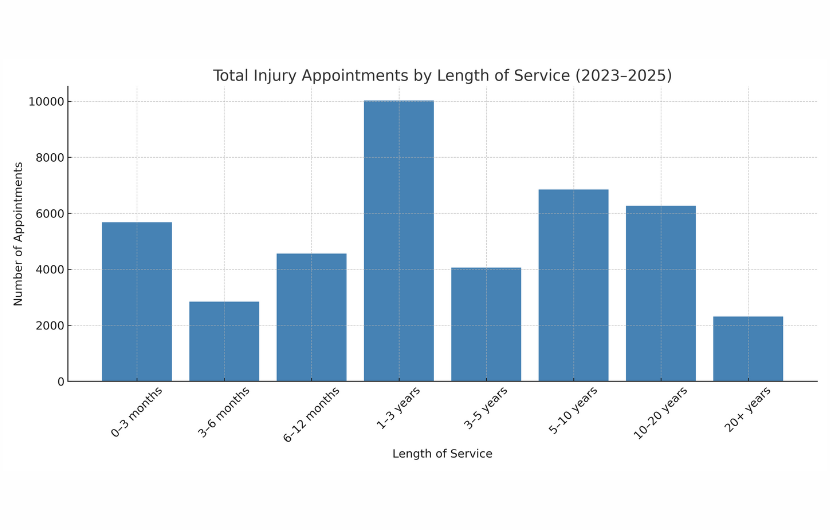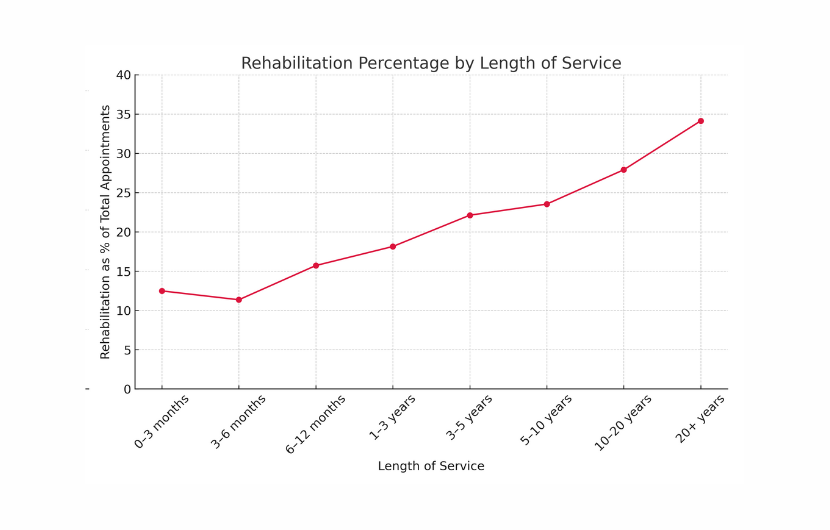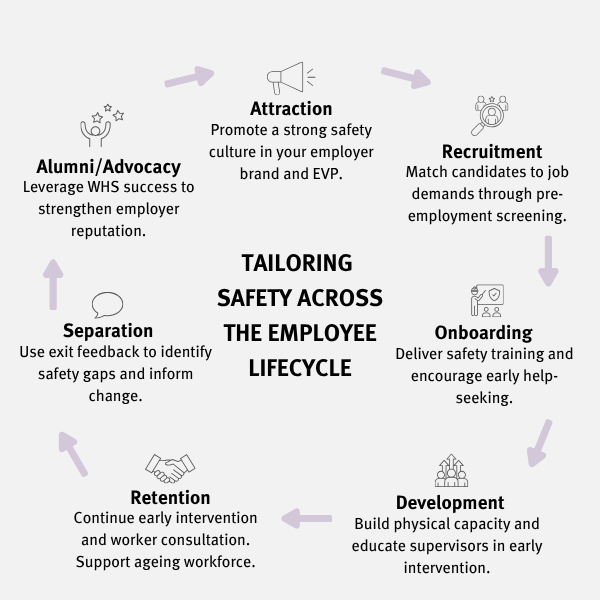
Risk doesn’t exist in isolation. As employees progress through their careers, the nature and intensity of injury risk changes. Understanding how exposure shifts over time will enable you to develop targeted safety strategies to support your workers at every stage of their employment journey.
How injury risk changes with age and tenure
Risk is dynamic. It shifts as workers move through recruitment, onboarding, development, and later career stages. Injury management data from a range of industries shows a consistent trend:
- Most injuries occur in early employment
- But the most complex and costly cases emerge in later years
Sustained early intervention throughout a worker’s journey is key to breaking this cycle.
High-risk zone: 1st year of employment
Across sectors as diverse as manufacturing, animal care, and local government, early tenure employees are consistently overrepresented in injury statistics. According to international and Australian research, approximately 30% to 40% of new employees sustain an injury within the first year of employment.
New workers face increased risk due to:
- Lack of familiarity with equipment, procedures, and safety protocols
- Lack of physical conditioning for role demands
- Insufficient task-specific competency
- Gaps in onboarding or safety training
- Reluctance to report early discomfort or hazards
This is supported by international evidence. The 2023 Travelers Injury Impact Report (USA) found that 34% of workplace injuries occurred within an employee’s first year. Work Healthy Australia’s data, collected over 25 years of occupational injury management, also supports the high-risk period of early employment.
In Australia, Safe Work Australia identifies new and inexperienced workers as high-risk due to similar factors. Young employees are also more vulnerable to psychosocial hazards, including poor supervision, low job control, and workplace stress.
Established workers: a changing risk profile
Injury risk doesn’t disappear with tenure – it evolves. As employees progess through their work and age, several factors can elevate their risk:
- Physical changes and declining musculoskeletal resilience
- Longer recovery times following injury
- Cumulative exposure to physical demands and prior injuries
Safe Work Australia reports a growing share of serious claims among workers aged 65 and older, signalling the need to adapt safety protocols to support an ageing workforce.
Career mobility and injury exposure
Historically, age and tenure were closely linked. Today, that’s changing. Increased job mobility and career shifting mean workers now experience multiple transitions between roles, industries, and risk environments.
Injury prevention strategies must account for this fluidity and prepare workers for new exposures throughout their careers.
What Work Healthy Australia’s data shows
Analysis of injury management data across a variety of industries reveals two clear patterns:
- Injury risk is concentrated in early employment. The first 12 months represent a critical window for risk mitigation. Proactive onboarding, mentoring, and access to onsite care can significantly reduce the likelihood of injury.
- Chronic injury risk grows with tenure. While longer-tenure employees are less frequently injured, their injuries are often more complex. These cases require longer treatment durations and are more likely to involve rehabilitation services.

The table above shows that, from the workers we treated over a three year period, employees with 1 to 3 years of service account for the highest number of injuries treated, followed by the 5 to 10 year and 0 to 3 month groups. This suggests that:
-
Injury frequency peaks around the 1 to 3 year mark, not just in the initial months.
-
A second spike occurs in early tenure (0–3 months), reinforcing the importance of onboarding and early intervention.
-
Mid-tenure (5–10 years) also presents a notable burden, indicating the need for sustained injury prevention efforts beyond onboarding.

The table above shows workers we treated for rehabilitation – conditions that are complicated by an underlying musculoskeletal health concern or comorbidity. These cases are more complex and will generally take longer to treat. They will incorporate active management and or lifestyle advice for their presenting health concerns.
The percentage of rehabilitation appointments rises steadily as employees accumulate more time in their roles. This suggests that:
-
Injury complexity increases over time, not just in the initial months.
-
Late-career employees are more likely to have complex, chronic, or persistent conditions due to overuse injuries, ageing and co-morbidities. requiring longer recovery and treatment
Strategic implications for employers
-
- Prioritise onboarding and early tenure support. Embed structured safety onboarding, mentoring, and access to onsite clinicians within the first 6–12 months of employment. It prevents acute injuries and sets expectations for safe work habits.
- Sustain early intervention across the full career lifecycle. Do not limit early intervention to new starters. Provide ongoing access to treatment and education for longer-serving staff to prevent chronic issues.
Use data to drive tenure-specific safety strategies. Injury risk is not evenly distributed. Tailoring programs to tenure groups can drive both claim reduction and better workforce planning. - Invest in upstream support for high-risk roles. In roles with high physical demands, cumulative exposure leads to chronic conditions. Early detection and regular reassessment are critical.
- Understand your organisation’s unique trends. Each organisation displays unique trends, reflecting differences in risk exposure, workforce demographics, and intervention strategies.

Additional considerations
- Job and sector variability: While early-tenure risk is consistent, the magnitude varies by role, industry, and individual characteristics.
- Job turnover and career changing: As employees switch jobs, they may be re-exposed to early-tenure risk environments.
- Psychosocial risk: Hazards such as stress, poor management, and low job control fluctuate by tenure stage and influence physical injury risk.
- Continuous risk management: Safety systems should adapt as workers progress through their careers, not just at the start.
Injury risk is not static. It evolves alongside tenure, experience, and work exposure.
Organisations that understand this lifecycle can implement targeted, effective interventions that reduce claims, improve recovery, and support a safer, healthier workforce.
Sign up to our monthly enewsletter
"*" indicates required fields
